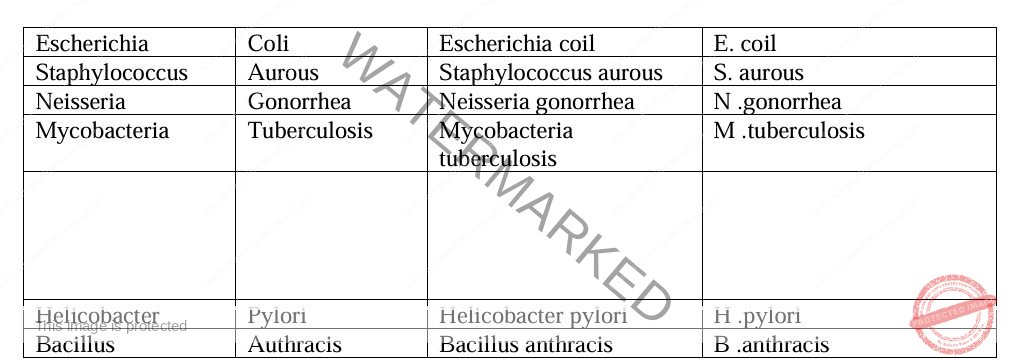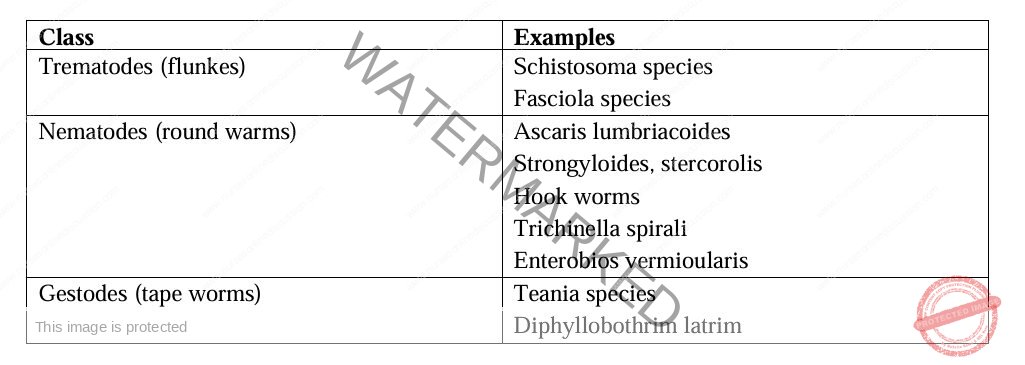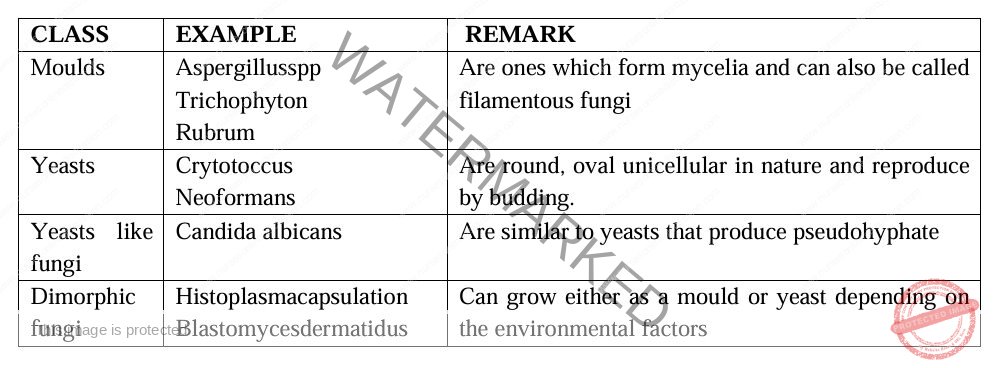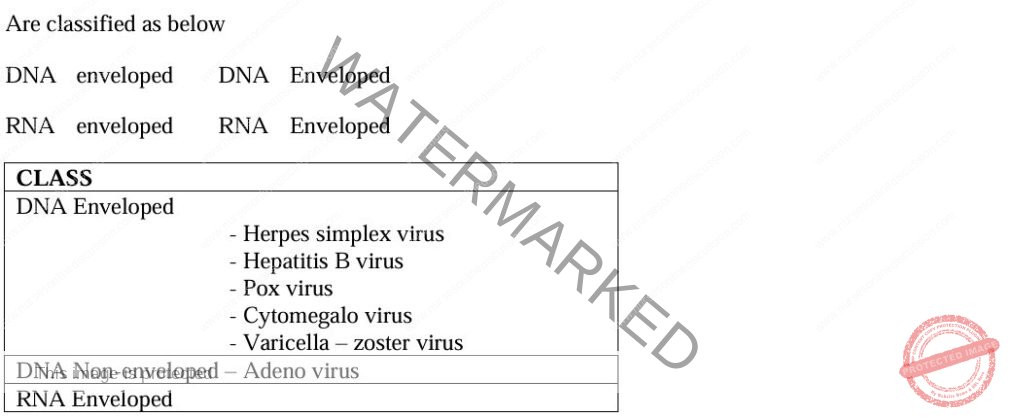Microbiology
Subtopic:
Characteristics and Mode of Spread of Disease-Causing Microorganisms
Bacteria
Bacteriology is the scientific study of a bacteria. Bacteria are single celled prokaryotic organisms and are the most common cause of infections in the community.
Structure: SIMILAR TO THAT OF THE PROKARYOTIC CELL.
Functions of Different Parts of a Bacterial Cell:
Cell walls: is the strong protective outer covering of a bacterial cell and is composed of peptidoglycan layer. Gives the cell rigidity and support to maintain shape. Protects the bacterial against external osmotic pressure. Is in involved in cell divisions.
Cell membrane (cytoplasmic membrane): Is a semi permeable and allows only certain substances like water, to enter and leave the cell while inhibiting others. It controls the movement of water, ions nutrients and excretory substances in and out of the cell.
Cytoplasm: Is a viscous gel containing many solutes which forms inside of the cell. Reduces friction between the cell organelles.
Capsule: Is the outer most layer of some bacteria’s. Provides protection resisting destruction by means like phagocytosis. Are important virulence determinants as are able to a touch on hard and rough surfaces and poor environments.
Ribosomes: Are small particles in the cytoplasm and in the nuclear region of the cell. Produce proteins required for reproduction and growth.
Fimbriae(pili): Are thin hair like appendages that arise from the cytoplasmic membrane. Are mostly found in gram negative and some gram positive bacteria.
Flagella: Are long thin spiral shaped filaments consisting of proteins. Facilitates locomotion in motile bacteria.
Spores: Are small metabolically dormant cells with thick walls, common with bacillus and clostridium. Spores are highly resistant to heat, other disinfectants and boiling. Protect bacteria in hostile environment i.e. with radiation, delay duration etc.
Bacterial Nomenclature (Taxonomy): Refers to a system of organizing, classifying and naming of bacteria for the purposes of easy identification. Levels of taxonomy in descending order: kingdom, Phylum, Class, Order, Family, Genus, Spices.
Bacterial are named according to a binomial system which is a formal system of naming species of living things by giving each a name composed of two parts. In binomial system, the genus name is started with a capital letter and species name with a small letter.
Example:


Classification of Bacteria:
Bacteria may be classified in many ways basing on Shape, Staining, Oxygen requirement, Temperature requirement, Toxin production, Spore formation.
Classification According to Shape:
COCCI: These are a rounded or spherical in shape and is divided into three i.e.
a) Diplococci: These appear in pairs e.g. Neisseria gonorrhea, Neisseria meningitides.
b) Staphylococci: These appear in clusters or groups e.g. Staphylococcus aurous, Staphylococcus epidermis, Staphylococcus saprophytic.
c) Streptococcus: These appear in chains e.g. Streptococcus pyogenes, Streptococcus pneumoniae, Streptococcus agalactiae.
Bacilli: These are rod shaped bacteria e.g. E.coli, Clostridium tetani, Bacillus anthracis, Shilgella species.
Spirochetes: These are bigger than bacillus and cocci in size and appear in spiral form e.g. Treponema palladium which causes syphilis.
Classification According to Oxygen Requirement:
a) Obligatory aerobes. These bacteria strictly require free oxygen to service e.g. pseudomonas aeruginosa.
b) Miro-aerophilic bacteria: these grow better in the presence of low oxygen to concentration e.g. campylobacter jejuni.
c) Obligate anaerobes: these grow only in absence of oxygen e.g. clostridium tetani
d) Facultative anaerobes: these can grow in presence or absence of oxygen e.g. Staphylococcus aereus, Streptococcus pyogenes, Escherichia coli.
e) Carboxyphilic bacteria: these require an environment with is carbondioxide e.g. Neisseria meningitides.
Classification According to Staining:
Bacteria are commonly classified basing on to the reaction to certain stains. The commonly used stains to classify bacteria include Gram stain and Acid fat stain.
i) Gram Stain: Is divides bacteria into gram positive and grain negative bacteria depending on the way they react to the gram staining technique as below.
Gram positive bacteria: Cell walls are thick and contain large amount of peptidoglycan layer e.g.
COCCI: Staphylococcus aereus, Streptococcus saprophyticus, Streptococcus agalactias, Streptococcus pyogenes.
BACILLI: Clostridium tetani, Clostridium difficle, Bacillus anthracis, Clostridium perfringens.
Gram negative bacteria: These have thin cell wall and contains small amount of peptidoglycan layer e.g.
BACILLI: Haemephillus influenza, Escherichia coli, Klebsiella pneumoniae, Vibrio cholera, Brucella species, Haemophilus ducreyi, Shigella species, Salmonella species.
COCCI: Neisseria meningitidis, Neisseria gonorrboeae.
Classification According to Temperature Requirement:
Different bacteria live /stay in different temperature.
Psychrophiles; can grow at cold temperature of O-15°C
Psychrotroph; can grow at temp ranges of (20-30)°c for optimal growth
Mesophiles. Can grow at moderate temperature of (25-40) ºC. And its where we meet most of the medically important bacteria since most of human pathogens ideal temperature is about 25°c
Thermopiles, Can grow at temperature of above (55-65 to 80)0c
Hyperthermophiles, Can grow at temperature of (80-135)0c
Classification According to Toxin Production:
Some bacteria produce toxins as their defense mechanism and they are either, endotoxic or exotoxic.
a) Exotoxic: These produce toxins outside their cell membrane. They cause diseases with acute rapid onself because the toxins are produced directly into blood circulation e.g Cholera.
b) Endotoxic: These produce toxins inside their cell membrane. They cause diseases which have gradual on set as their toxins are not poured directly into the blood circulation.
Classification According to Spore Formation:
Bacteria like clostridium tetani, E coli, and klebsiella pneumoniae form spores for protection against heat mostly in dry conditions and other materials like drugs. Some bacterias are unable to form spores eg Vibrio choleraea, Nisseria spp, Pseudomonas aeroginosa.
Bacteria Growth and Development: They reproduce by binary fission, where a cell divides into two identical daughter cells which are able to grow and divide at some rate as parent cell.
Generation time: Time required for the number of bacteria in a cultural media to double e.g. staphylococcus aureus 20-30 minutes, E’coli 30 minutes, M tuberculosis 15-20 hours, Clostridium tetani 40 minutes.
Conditions Necessary for Bacteria Growth:
Aeration:
Different bacteria need different levels of aeration for growth e.g aerobic Bacteria need oxygen, facultative can grow both in presence of oxygen and carbon dioxide and anaerobic need CO2.
Temperature: Each bacterium has its own temperature range within which optimum growth takes place i.e. psychrophilic grow in range of 0-15, psychrotrophs 20-30. Mesopliles 25-40°c, thermophiles 55-65 up to 80°c and hyperthermophiles 80-130°C.
Moisture:
Three quarters ¼ of bacterial cell contain water, this moisture is necessary for growth. And the need of water/moisture by different bacterial varies i.e. Treponema pallidium dies almost at once in the absence of moisture while tubercle bacilli can survive for several months without moisture.
PH (potentials of Hydrogen): PH is the degree of alkalinity or acidity of an environment. A number of bacteria grow best at various PH levels although most bacteria require neutral PH of 7. Bacteria are divided as below basing on PH ranges acidophile require a PH of 0-5.5, neutrophile 5.5 -8, alkalophile 8.5-11.5, for their optimal growth.
Darkness:
Most bacteria grow well in dark areas because ultraviolet rays are bactericidal to them and only a few of them can survive.
Nutrients: Carbon is needed for synthesis of protoplasm i.e microbes obtain their carbon from carbon dioxide, carbohydrates, lipids and proteins. Nitrogen is from ammonium compounds and amino acids for synthesis of proteins and nucleic acids of the cell.
Mineral Salt:
Sulphur obtained from proteins, phosphates are needed for the production ATP which is used in synthesis of nucleic acids (RNA AND DNA) magnesium, potassium and calcium stimulates enzymes to become active.
Osmotic Pressure:
Is the pressure exerted on Bactria by their surrounding. variation in osmotic pressure affects the bacterial growth.
The Pattern of Bacteria Growth:
Under suitable conditions such as availability of nutrients optimal PH, right temp etc. bacterial cell wall will increase in size and then divide into two identical bacterial cells. The growth of a colony of bacteria in a laboratory under controlled conditions can be described in four major phases:
Lag phase:
Is usually associated with adaption of bacteria to the new environment, increase in metabolic rate and enlargement in size of the cell.
Log (exponential) phase: This is the growth phase where active binary fission occurs. During this phase, most bacteria are metabolically active and cell production is at its peak. Its at this stage that bacteria are very resistant to antibiotics and this rate of growth is maintained as long as conditions remain favorable. Betalactum antibiotics such as penicillin’s and cephalosporin’s act during this phase.
Stationary phase:
The no of cells produced is almost equal to those that are dying. This may be due to accumulation of toxic products, lack of nutrients and limited space; some bacteria may start producing spores at this stage.
Decline (death) phase: This is the last phase of bacterial growth and it represents a decline in the number of dividing cells, generally the number of bacteria dying exceeds the number of those being produced. The decline may be due to buildup of waste toxic materials and exhaustion of nutrients.
Protozoa
Protozoa are single celled organisms’ occurrying both as free living organisms and as parasites.
They are eukaryotic organisms. Protozoa have a complex life cycle involving trophozoite and cysts. The cyst formed enables protozoa to survive in harsh conditions even outside the host. They replicate a sexually by binary fission and sexually with gamete formation. They cause diseases as a consequence of their infestation but symptoms occur as a result of immune response.
Classification of Protozoa:
Are classified into four major groups depending on their means or mode of reproduction and mode of locomotion.
a) Amoeba (rhizopoda): E.g Entamoeba, move by pushing out their ectoplasm to form a pseudopodia and reproduce a sexually by binary fission. Have two stages i.e.Trophozoites. Which is motile and able to feed and Cyst. The infective form that is capable of surviving outside the body.
b) Ciliates: e.g Balantidium coli, they have multiple cili (hair like structures) attached to the outer surface for locomotion. Reproduce by binary fission and sexually by conjugation. Ciliates form cyst which is the infective form.
c) Sporozoa (coccidia): e.g plasmodia spp, toxoplasmodia and cryptosporidium, all sporotozoa are intercellular and non motile. Reproduction is both by a sexual (schizogony) and sexual (gametogony) they have multiple stages in their life cycle i.e. oocyte, sporozoites, trophozoites and merozoites.
d) Flagellates (mastigophia): e.g giardia spp, trichomonos spp, typanosoma spp and leishmania spp. Usually have long hairy flagella for movement, they reproduce a sexually by binary fission. They exist in two forms in their life cycle i.e cysts and trophozortes.
Mode of Transmission of Protozoa Infections:
Person to person contact, Insect bites e.g. malaria, Sexual contact with the infected person e.g. trichomoniasis, Fecal-oral route through ingestion of contaminated food or H2O e.g Amoebiosis.
Factors that Contribute to the Spread of Protozoa Infections: Poor sanitation that results into feacal contamination of the environment. Poor access to clean H2O. Lack of resources which results into failure to control vectors. Poverty. HIV infections which increase susceptibility of parasitic infections.
Helminths
Helminths are eukaryotic parasitic worms that live mainly in the gastro intestinal tract of human host. Unlike bacteria and virus, helminthes are often large organisms. The infective larval forms are usually smaller than adult worms. The infections are usually common in developing countries and affects more of children than adults. NB. Helminthiosis. A disease condition resulting from infection with parasitic worms.
Classification of Helminths:

NB. Trematodes and nematodes feed on human tissue and the content of host intestines. Tape worms lack digestive systems therefore have to feed by absorption of digested nutrients from their hosts.
Mode of Transmission: Fecal oral route, Inhalation of dust, Penetration of skin by larvae from contaminated soil e.g. hook worms.
Fungi
Classification of Fungi: Fungi may be classified into 4 groups as depending on their appearance and means of growth as below.

Differences III Moulds and Yeasts:

Viruses
Definitions of Common Terms Used:
Casped. The protein shell surrounding the nuclei acid virion.The complete infective virus particle.
Genom. Is either the RNA or DNA contained in the viral capsid.
Fusion. Is the process by which viruses attach themselves to cell membranes of the host cells for the purpose of viral replication.
Envelop. Is a lipid membrane of the host cell.
Transcription. Mechanisms by which specific information encoded in nucleic acid chain is transferred to the RNA and translate on ribosome through RNA into the structures of protein.
Viruses are very small microorganisms only seen by electronic microscope. Are obligate intracellular pathogens which can only multiply in living cells of host. Contain either DNA or RNA as their genome. Are metabolically inert outside the host cell. They survive by altering the function of the cells they impact so that these cells supply the viruses with energy and means of replicating themselves.
Structure of a Virus: They contain on external protein coating called capsizedcontaining nuclei acid in form of DNA of RHA. The nucleic acid controls infected cells and help in their division to for more nfected cell which invade other neighboring cells. Surface protein help in recognizing and binding the cell in host organisms. (See diagram on page 27 for visual representation including Surface protein, Capsid, Viral genetic material (DNA or RNA), Viral envelope).
Mode of Transmission:
Viruses may be transmitted through any of the following ways: Inhalation of airbornes droplets e.g measles, influenza etc. Ingestion of food or H2O contaminated with viruses e.g hepatitis A. From infected mother to mother unborn baby (vertical transmission) e.g HIV and Rubella viruses. Sexual intercourse with an infected person e.g HIV. Through animal bites such as rabies viruses. Inoculation with the aid of injections, insect bites etc. Through body contact e.g ebola and Marburg.
Viral Replication: Viruses only multiply in a living cell and below are he steps adoption/attachment.
Entry/penetration: Once the vinon has been attached to the receptor. It gains access to the interior of the cell by either endocytosis or fusion of virus envelope with the cell membrane.
Uncoating: Occurs immediately after penetration and involves release of viral genome as the cell enzymes (gysosomes) strip off the virus protein coat. During this step, the infectivity of the parental virus is lost.
Synthesis of virus components: Involves synthesis of viral proteins and replication of viral genomic nucleic acid.
Assembly: Involves assembly of capsid, and association of the viral genomic with in the capsid.
Release: Involves sudden rapture of cell and release of new various. Occurs by either lysis or budding off from the parent or host cell.
How Viruses Cause Diseases:
NB. Viruses are capable of infecting all types of living organisms such bacteria, plants, insects and human cells. A major factor that controls which cell type a virus can infect (cell tropism) “cell tropism” is the presence of appropriate receptor to which the virus must attach in order to gain entry into cell.
Classification of Viruses:

Related Topics
- Concepts of Microbiology
- Classification and Types of Microorganisms
- Pathogenic Microorganisms
- Normal Flora
- Characteristics and Mode of Spread of Disease-Causing Microorganisms
- Pathological Effects of Microorganisms
- Simple Laboratory Tests
- Infection Prevention and Control
- Introduction to Immunity
- Antibodies
- Principles of Immunization
Get in Touch
(+256) 790 036 252
(+256) 748 324 644
Info@nursesonlinediscussion.com
Kampala ,Uganda
© 2025 Nurses online discussion. All Rights Reserved Design & Developed by Opensigma.co

